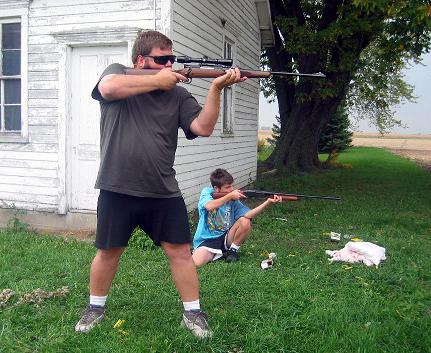Repost.
My interpretation of a tire blowing. And yes, it’s an -06

Repost.
My interpretation of a tire blowing. And yes, it’s an -06

Jag,
I must have read over this too quickly the first time. I just now got what you meant. Thanks for your vote of confidence. I love you too, man. ![]()
Bruce
Re: Why did my tire explode?
“harper” <harper@NoEmail.Message.Poster.at.Unicyclist.com> writes:
> And I said of
> ORDER one kilo-joule so 300 joules to 3 kilo-joules.
Could you rewrite this so it makes sense?
Wait - I get it! I think you are saying a tire has on the order of
1kJ energy, meaning its pressure is within the range 0.3-3 kJ. As
usual, you are correct: By my reckoning, the energy stored in the tire
in question (28x1.75 tire at 67 PSI) was about 0.5 kJ.
There was also the question of why the wheel exploded when unattended.
Nobody has mentioned the fact that a wheel locked inside a car may
heat up, increasing its pressure. A 50 degree F change in temperature
should increase pressure by 10%. That’s not a whole lot, but it is
conceivably a contributory factor.
Ken
I blown 2 tires on my POS over the last 35 yrs …
I was always my fault.
I always rode street, until recently, So I like a hard tire.
(Keeps me from bending/denting the rim.)
They make a nice pow when they blow 
i have a sun 28 also (haven’t ridden it in a while). but i remember the tire that it comes with is thin and cheap.
take a look at this thread . i wanted to see if a 29in tire could be used with the sun 28 frame. turns out the answer is no. but a better tire is the Michelin Transworld City 700c/47c.
-Eric
I think this may be the first case of a weapon being used in a thread-jacking.![]()
Pinch-flats are caused by coming down too hard with not enough air in the tire. If you’re jumping hard, weigh a lot, have a skinny tire, or ride on rouch, sharp surfaces, pinch-flats can be an issue. Usually they are not an issue for flatland riding, unless it involves lots of hops or jumps.
But for Freestyle riding, especially outdoors where the riding surface tends to be rougher, high pressure is usually preferred. Lots of air reduces rolling friction, and allows you to turn and spin more, with less wear on the tire.
As your tire pressure goes up, the strains on the tire and rim do as well. So tire fit becomes more important as you increase the pressure.
I have had my share of blowouts, including one in January on my 29". Fortunately I was outside, because it too sounded like a gunshot. It happened when I landed a little drop while riding down a rocky slope. In my case, I think it may have been a defect in the tire. Afterward, there was not only a gaping hole in the tube, but the tire’s wire bead was broken. If the bead (or rubber) had a weak spot in it, this may have allowed the tire to fail. Or the tire was improperly seated, which is possible though less likely because I think I did a good job of installing it.
Anyway, when installing a tire, or inflating it for the first time, it’s important to check that it’s seated evenly. I usually start by putting in just enough air for the tire to hold its shape, then bounce it around while slowly rotating it. This helps “knock” the tire into position. Then I add some more air, and check the even-ness of the bead line. To do this, give the wheel a spin and watch the point where the tire enters the rim. Most tires have some sort of line here, and you can see if this line is staying an even distance from the rim, or rising and dipping. No dips! If it’s not even, let most of the air out and try again.
Sounds like those Suns may have some low-end tires, and may have been seated a bit crooked when they were pumped up.